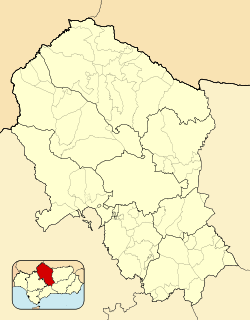Pozoblanco, Córdoba
| Pozoblanco | ||
|---|---|---|
| Municipality | ||
|
||
 Location of Pozoblanco in the province of Córdoba. |
||
| Location in Spain | ||
| Coordinates: 38°23′N 4°51′W / 38.383°N 4.850°W | ||
| Country |
|
|
| Autonomous community |
|
|
| Province | Córdoba | |
| Comarca | Los Pedroches | |
| Judicial district | Pozoblanco | |
| Government | ||
| • Alcalde | Pablo Carrillo | |
| Area | ||
| • Total | 329.92 km2 (127.38 sq mi) | |
| Elevation | 654 m (2,146 ft) | |
| Population (2010) | ||
| • Total | 17,796 | |
| • Density | 54/km2 (140/sq mi) | |
| Demonym(s) | Tarugos or Pozoalbenses | |
| Time zone | CET (UTC+1) | |
| • Summer (DST) | CEST (UTC+2) | |
| Postal code | 14400 | |
| Official language(s) | Spanish | |
| Website | Official website | |
Pozoblanco (Spanish pronunciation: [poθoˈβlaŋko]) is a town in the province of Córdoba, southern Spain, in the north-central part of the autonomous community of Andalusia. It is located near the headwaters of the Guadamatillas and of other small sub-tributaries of the Guadiana, in the lowlands of Los Pedroches, which lie between the Sierra de la Alcildia on the north and the Sierra Morena on the south.
It is the birthplace of the novelist Rafael Peñas Cruz and the composer Lorenzo Palomo.
Pozoblanco, like other nearby towns such as Villanueva de Córdoba, likely originated in the mid 14th century when residents of nearby Pedroche fled from the bubonic plague. Alternatively, Pozoblanco may have begun as a small outpost that developed over time as residents of Pedroche were forced to pasture their livestock farther and farther from the town. Another possibility is that Pozoblanco was founded by a Jewish community, perhaps after being expelled from Pedroche.
The first settlements were in the area known today as “Pozo Viejo.” According to tradition, the town grew up around a well that had turned white from the excrement of chickens, hence the name Pozoblanco, meaning “white well.” The well and chicken may also be seen on the town coat of arms.
Pozoblanco depended administratively on Pedroche until it obtained the title of Villa around 1478. In the medieval era, the history of Pozoblanco is tied to that of the so-called “Seven Villas of the Pedroches” (Pedroche, Torremilano, Torrecampo, Pozoblanco, Villanueva de Córdoba, Alcaracejos and Añora). This community was broken up in 1836 and the communal lands were redistributed among the towns. Pozoblanco received the title of city from King Alfonso XIII on April 22, 1923.
...
Wikipedia



